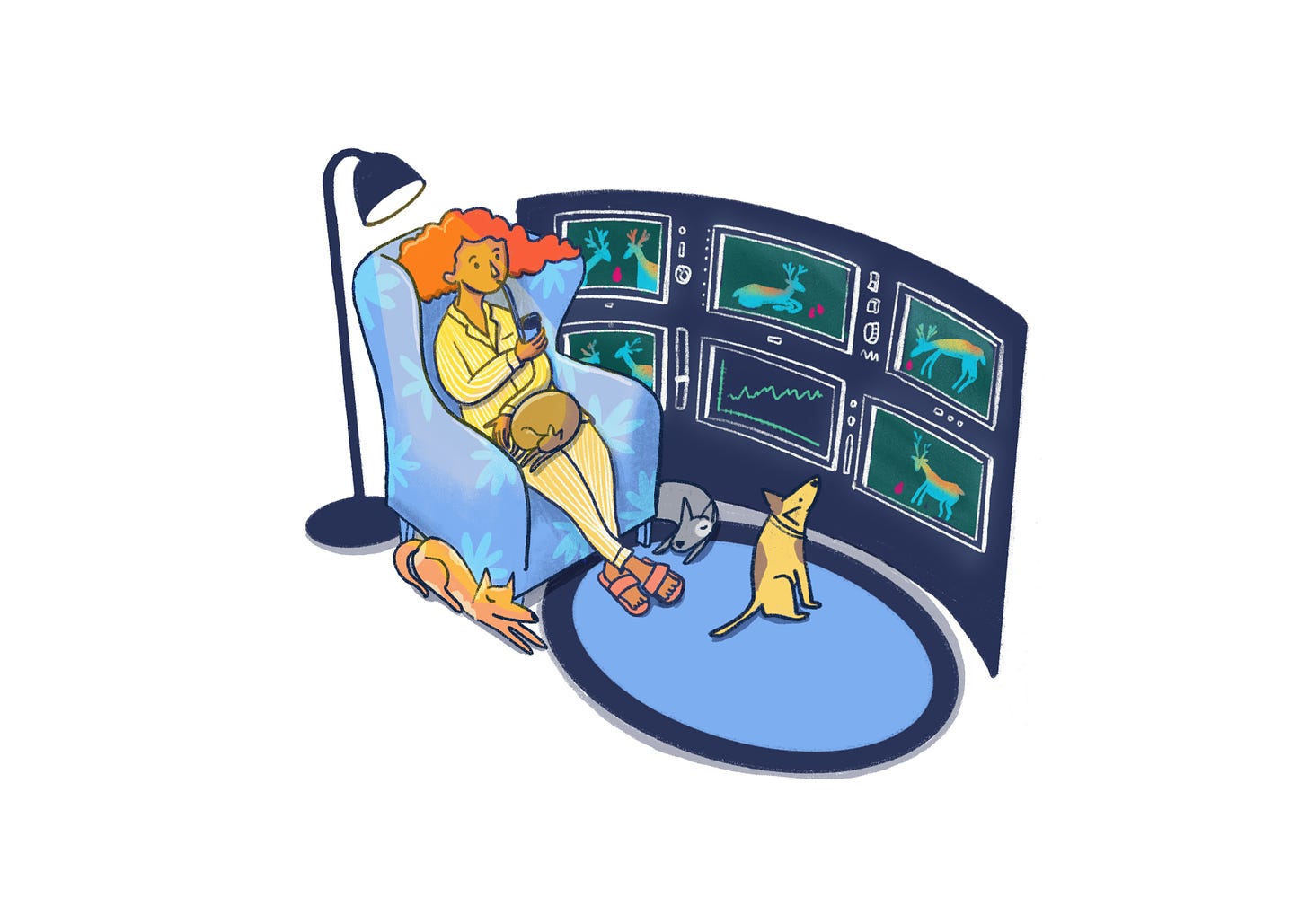Editors note: This is an exploration of a presentation we did for a PE portfolio on cookies, iOS14, advertising & attribution. As more of the open internet turns into walled gardens - it drastically changes the promise the internet was built on. Increasingly the soul of the internet has become a fight over private corporations trying to control it under the guise of privacy.
Philosophical musings aside - there’s also a profound impact on marketing & attribution. We’ve grown up on the promise from vendors of tracking every single click & impression to tie back to revenue. Increasingly it’s harder to track ‘where’ people are coming from & which channels are working. This is why first-party data is at a premium & tech companies are buying media companies.
Written by Sebastián Cuervo. Illustrations by Alejandra Céspedes.
If you like the Illustrations. They are now available as Non Fungible Tokens on Opensea.
The Cookie Apocalypse: iOS 14
iOS 14 is introducing app transparency tracking (ATT) to help their customers own their data (or so they claim). In general, what ATT does is ask iPhones for "authorization to access app-related data for tracking the user or the device." Most users seem to think this is amazing. I mean, who would not want to have more control regarding the information shared online?
But, for the rest of us (especially marketers), this represents a challenge that takes us back to a time when tracking user behavior via cookies was impossible: the pre-internet era.
The time before time: Pre-internet Marketing
Measuring marketing effectiveness before the internet was, in many ways, a lot harder (measuring anything really). There were no cookies, and organizations had to rely on third-party data metrics to determine if things were working like Nielsen, Arbitron, Kantar, etc.
Marketers had to rely on channels that are still used today, such as billboards. Even though some contemporary marketers may dismiss this channel, billboards do work because, ultimately, people get to see your brand while commuting. It is not a coincidence that we still find ourselves overwhelmed with visual noises on highways and generally in places with lots of traffic.
As you can already guess, though there are ways to measure the effectiveness of OOH, it is only an estimate. It’s like throwing darts, while blindfolded. It was and still is, virtually impossible to calculate how many people looked up and saw your ad. But, if sales spiked since you started advertising on billboards, you can assume they worked. The equation is simplistic: calculate the cost of the billboard, the number of sales that you believe came from that channel, and then determine if the cost of having the billboard represents a significant return.
TV was also measured in ways that are not as precise nor easy. Even though there is a whole set of rules and a logic behind the attribution model used for TV, we’ll simplify it for this article. Crudely put, what marketers did back in the day was plot viewer sessions, place their ads in the most profitable timeslots given their target, and finally, test out on several networks to figure out which was the most effective.
There was no internet, so it was impossible to measure the impact of a particular ad on the overall sales in real-time. But by experimenting and using statistical models, brands could figure out which ad was more effective in which network at any given time.
It was not as precise, but it worked. It’s relevant to highlight that one of the reasons that TV was as successful as it was, is because the internet wasn’t around to capture eyeballs. It is not a coincidence that TV is still a significant player for brands today (we all know about the advertising hype during the Superbowl).
The Internet Marketing Era
The internet (particularly the social media era) allowed marketers to do a million things.
We were introduced to "free" dom.
Remember reading The New York Times, The Wall Street Journal, Wired, or whichever magazine or newspaper you like, before the internet? Perhaps you do, but for quite a few of us, it was almost impossible to access it.
Or, do you remember having the chance to watch audio/visual content without having to pay for a ticket to the theater? Me neither, at least not until Youtube and video overall started moving online.
In a nutshell, the internet allowed us to access meaningful content online for "free" because we were willing to let platforms and publishers place ads against the content. In a way, one could even argue that thanks to third-party cookies are part of what allowed the internet to be “free”.
But, before we continue talking about third-party cookies, perhaps we should start quickly defining both first-party and third-party cookies.
First-party cookies allow users to experience the internet in a much more fluid way. These cookies allow browsers to store information, track digital sessions, and ultimately let people better surf the web. Cookies are precious, and they took internet usability to the next level. Imagine having to log in every time you switched between pages of the same domain (that was not a problem thanks to cookies). First-party cookies simplify our digital experience, and quite frankly, the internet probably would not be as much fun without them. Thank you, Lou Montulli!
On the other hand, we also have third-party cookies. Which, in essence, are tracking user behavior. These cookies are not placed by the domain you visit or to enhance the experience of the site but to enable marketers & advertisers to understand your behavior better.
Why would anyone create such a thing?
Short answer: to enable publishers and brokers to sell your digital behavior to brands. Third-party cookies created a marketplace around advertisers, publishers & brands.
In other words, third-party cookies allowed major digital players (Facebook, Google, Amazon, etc.) to track your behavior, preferences (even indirectly - as a third party) and generate money with help from marketers. It was the way to empower professionals who wanted to sell things online to create buyer segments, push ads, and ultimately, sell.
This became even more potent once marketers figured out how to use UTMs and their importance in tracking exactly how the users behaved and arrived at their site (and ultimately, how they behaved in the sales funnel). It was terrific to figure out where any particular user came from, their digital route while arriving at a site, and then analyzing how to minimize friction and increase conversion rates.
But, all of this radically changes if third-party cookies cease to work.
Today, and since iOS 14, Apple blocks third-party cookies (if the user wishes to do so). They have created this mesmerizing Apple experience ad to convince us that not being tracked is aspirational. They have also made this more objective and less edgy video to explain why privacy is important to its users.
Safari also announced it would delete 1st cookies after seven days of not being used. Likewise, Facebook is rebuilding the way it gathers information...to know less about you. Yes, you read that correctly.
And, even Google Chrome is trying to FLOC the internet and move away from third-party cookies. Not the most popular move.
So what happens now that Apple and many others want to close their gates and stop third-party cookies from working? What impact does it have on marketers?
What can you do as a marketer to face the cookie apocalypse?
First of all, as marketers without third-party cookies, we should start by accepting the reality that targeted ads will become less effective. In other words, brands will spend more money to reach ROI targets across digital channels.
So what can marketers do? Hubspot's acquisition of The Hustle might hold some insights.
Why did Hubspot buy The Hustle? Simple answer - first-party data and reach. Longer answer - Hubspot sees the writing on the wall where their current channels become less effective over time. Hubspot heavily relied on SEO to build itself up to where it is today. But SEO has a natural ceiling, and Hubspot is beginning to write more' top of funnel' content (that does not directly tie into the product) to capture very generic traffic. A classic example is this post - How to Type the Shrug Emoji ¯\_(ツ)_/¯ in 2 Seconds Flat.
In other words, Hubspot may have already tapped out SEO searches from people looking for marketing solutions, and in theory, they have 'reached the ceiling' on those types of prospects. While they leverage paid ads, the ads are getting less effective over time, as we've all seen.
This is where the Hustle comes in. The Hustle is an online media company focused on helping people start new businesses or understand current businesses. They have a massive email list & social media presence with an estimated reach of 2M people.
The Hustle gives Hubspot a few things:
An audience of people who are potential Hubspot customers (starting a business or work in business/tech).
Access to people’s inbox (no relying on 3rd party ad platforms for reach).
First-party data on 2M people (emails, phone social, etc) that can potentially be used for ads, lookalike modeling & other marketing purposes.
For a deeper dive into media operations & why tech companies are buying media companies - don’t forget to subscribe
So what can you start doing today as a marketer facing the cookie apocalypse?
Leverage 1st party data. Do your best to capture as much information about the people who visit your site in the least invasive way possible. Provide people with interesting resources (ebooks, podcasts, case studies, articles, etc.) that they would be willing to hand over their data for. And, make sure you use all of the potentials of your CRM to map out the user's journey and how to solve their problems given their stage on the funnel. If the user is just learning about your brand, don't rush to sell them something they do not even know they need. If, however, they are almost ready to buy, perhaps you could pass this particular lead to a sales representative to close the deal.
The most outsized success will come from focusing on understanding each of your users (and the somewhat homogeneous behavior that emerges from their respective segments).
To do this, finding user patterns and testing out sales strategies with user segments with similar behavior is critical.Do not overly rely on UTMs / First Touch / Last Touch. As we’ve mentioned above, UTMs are great because you can determine where users come from. With first-party data blocked, this is simply not going to be as effective. We are not saying that we should forget about it altogether, but rather, that it is important to understand that marketing resilience is vital.
UTMs, by nature, rely on being stored in first-party cookies. They are a relic of Urchin Tracking (which Google acquired and is GA as we know today). But as Safari (and we think other browsers will follow suit) delete first-party cookies after seven days - you’ll see increasingly higherspikes in ‘Direct Traffic.’ Meaning, users will appear to have arrived ‘directly’ to the site when in fact, they came via some other channel. If cookies are erased, analytics tools can’t tie them back to their source.
In other words, developing adaptative frameworks to know where users come from is more critical than strengthening UTM parameters or tracking technologies. More than ever, it is essential to make sure your organization is aligned and push all departments to develop a curious and genuine interest to figure out how users learned and purchase your product, service, or software. That might mean updating the script with your SDRs where they specifically ask prospects about how they heard about you, or it might mean you should create a post-purchase / demo form to survey prospects.
Move away from pure Performance Marketing. Traditionally marketers, especially B2B have been too focused on 1:1 ROI. If I put a dollar into X marketing - I need Y dollars back right away or some measurable result. Otherwise, budgets get cut & heads start to roll. The fact is that as these new changes begin to roll out - it'll be harder if not impossible to tie spend back to revenue by specific channels. As an example - currently / past, we could directly attribute pipeline and revenue generated from Adwords (via click tracking) and measure it against spend. As click tracking, parameters & other direct response attribution starts to phase out, along with reduced hyper-targeting abilities, marketing will find it challenging to justify "spend vs. return" on a channel basis.
Leverage Keyword targeting on display. Contextual targeting will probably gain momentum in a world where we know less about our users. If you happen to sell red shoes and set up campaigns on the display network that will contextually show your ad to people visiting sites that connect with that particular keyword, you will probably be able to drive more traffic to your site. This is also useful in building brand affinity - i.e., prospects will associate with your brand in the context of the content they are reading. Word to the wise, use exclusion sites (a 42 Agency Product) to manage your negative placements.
Use custom audiences. CRMs are a rich source of first-party data which store customer insights & prospect information their database.
As you build a content/media engine to gather more insights about your audience and prospects, you can start collecting information to build email subscribers, communities, and podcast listeners. Over time as you grow this database of first-party data, you can leverage it to build custom audiences (first-party data) & lookalike audiences (modeled first-party data)
Leverage Holistic Attribution Models to understand how marketing and nonmarketing touchpoints influence your business outcomes. Remember the old days of TV and Billboards and the predominant marketing medium? Well, maybe you can adapt and learn from what they did back then and start running:
Holdout tests. Experiments where Group A is exposed to advertising while group B is not. Then, measure the delta to determine 'how much revenue was driven by ads.' This is quite similar to what marketers did in the TV era but much more accurate given that you now have a precise tool that allows you to measure traffic to your site - Analytics.
Marketing Mix Modeling. Use statistical modeling to measure the correlation between different marketing campaigns. For example - the correlation between ads and the lift in organic conversions. Test and iterate multiple times with several marketing campaigns and determine what works best. It might not be as cheap or as effective as the third-party world, but you will surely understand and learn to understand your customer and what buttons to push to drive revenue.
Is this where the cookie crumbles?
The truth is that no one is quite certain if the third-party cookies and how our network economy creates capital will radically change. But the signals of a shift in privacy and access online are pretty powerful.
As marketers, we think it is essential that brands stop relying so heavily on tracking users online. Instead, brands should start creating more robust branding initiatives that allow users to remember them and prefer them instead of other brands. In other words, stop relying on repetition and work on your recognition.










